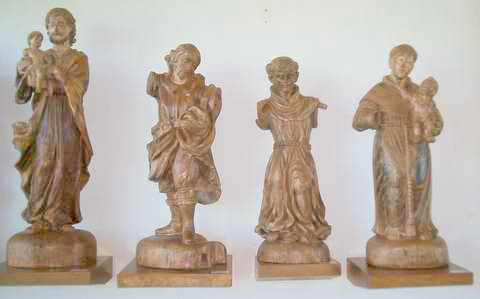 Dentro do sítio, há um museu projetado por Lúcio Costa e construído em 1940. Há cerca de 100 estátuas confeccionadas em estilo barroco pelos guaranis. Algumas estátuas tem mais de dois metros de altura. Na foto, alguns exemplos das imagens. There´s a museum inside the archeological site build in 1940, project by Lucio Costa. In the museum, there´s 100 statues build by indians. Some of them has 2 metres of height. Some examples of these statues in the picture.
Dentro do sítio, há um museu projetado por Lúcio Costa e construído em 1940. Há cerca de 100 estátuas confeccionadas em estilo barroco pelos guaranis. Algumas estátuas tem mais de dois metros de altura. Na foto, alguns exemplos das imagens. There´s a museum inside the archeological site build in 1940, project by Lucio Costa. In the museum, there´s 100 statues build by indians. Some of them has 2 metres of height. Some examples of these statues in the picture.
Neste espaço eu escrevo sobre minhas viagens, passeios e aventuras. Aproveite! I describe in this blog my adventures and trips. Have fun!
Thursday, June 29, 2006
Arte Missioneira / The art from the missions
 Dentro do sítio, há um museu projetado por Lúcio Costa e construído em 1940. Há cerca de 100 estátuas confeccionadas em estilo barroco pelos guaranis. Algumas estátuas tem mais de dois metros de altura. Na foto, alguns exemplos das imagens. There´s a museum inside the archeological site build in 1940, project by Lucio Costa. In the museum, there´s 100 statues build by indians. Some of them has 2 metres of height. Some examples of these statues in the picture.
Dentro do sítio, há um museu projetado por Lúcio Costa e construído em 1940. Há cerca de 100 estátuas confeccionadas em estilo barroco pelos guaranis. Algumas estátuas tem mais de dois metros de altura. Na foto, alguns exemplos das imagens. There´s a museum inside the archeological site build in 1940, project by Lucio Costa. In the museum, there´s 100 statues build by indians. Some of them has 2 metres of height. Some examples of these statues in the picture.
Tuesday, June 27, 2006
Igreja e gramado / Church and lawn
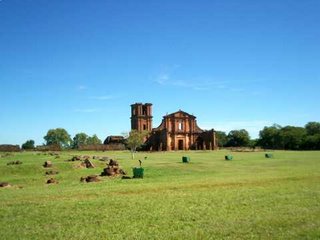 Visão da Igreja de São Miguel do Arcanjo à distância. Tirei esta foto onde fica a arquibancada em que se assiste ao espetáculo chamado "Som e Luz", o qual é uma representação eletrônica da história das Missões na voz dos artistas da Rede Globo. A voz de Fernanda Montenegro é facilmente reconhecível! O show ocorre todas as noites, de domingo a domingo. Distant view of the São Miguel do Arcanjo Church. I took this shot in the bleachers. It´s used to assist the daily show at night wich tells the history of the Missions in the electronic voice of famous brazilain artists.
Visão da Igreja de São Miguel do Arcanjo à distância. Tirei esta foto onde fica a arquibancada em que se assiste ao espetáculo chamado "Som e Luz", o qual é uma representação eletrônica da história das Missões na voz dos artistas da Rede Globo. A voz de Fernanda Montenegro é facilmente reconhecível! O show ocorre todas as noites, de domingo a domingo. Distant view of the São Miguel do Arcanjo Church. I took this shot in the bleachers. It´s used to assist the daily show at night wich tells the history of the Missions in the electronic voice of famous brazilain artists.
Sunday, June 25, 2006
Vista do altar / Altar view
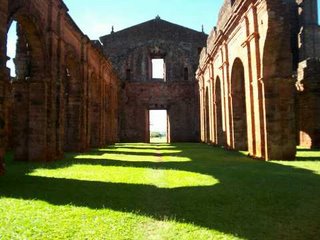 Vista dos fundos do interior da Igreja de São Miguel do Arcanjo. Desta vez, as sombras proporcionaram uma bela visão simétrica na fotografia. O local onde eu estava quando tirei a foto ficava o altar da igreja. Back inside view of the São Miguel do Arcanjo Church. This time the shadows allow a beautiful and simetric view of the picture. The place where I shot this picture was the altar of the chuch.
Vista dos fundos do interior da Igreja de São Miguel do Arcanjo. Desta vez, as sombras proporcionaram uma bela visão simétrica na fotografia. O local onde eu estava quando tirei a foto ficava o altar da igreja. Back inside view of the São Miguel do Arcanjo Church. This time the shadows allow a beautiful and simetric view of the picture. The place where I shot this picture was the altar of the chuch.
Saturday, June 24, 2006
No cemitério / In the cemetery
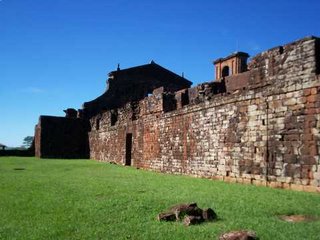 Vista da parede lateral da Igreja de São Miguel do Arcanjo. Neste gramado de onde tirei a foto ficava o cemitério. Nos seus fundos, que não aparece na foto, há um limoeiro. Outside view of the São Miguel do Arcanjo Church. In this lawn where I took this picture was the cemetery in the past. In the back of the lawn there is a lemmon plantation.
Vista da parede lateral da Igreja de São Miguel do Arcanjo. Neste gramado de onde tirei a foto ficava o cemitério. Nos seus fundos, que não aparece na foto, há um limoeiro. Outside view of the São Miguel do Arcanjo Church. In this lawn where I took this picture was the cemetery in the past. In the back of the lawn there is a lemmon plantation.
Friday, June 23, 2006
Parede da Igreja / Wall of the church
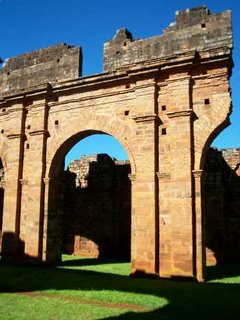 Interior da Igreja de São Miguel do Arcanjo, detalhe da parede que fica à esquerda de quem entrou pela porta principal. Observe as áreas escuras no topo da parede, provavelmente causadas por incêndios. São Miguel do Arcanjo inside. This picture is a wall of the left side considering you come in from the entrance. The darkned colour of the top of the wall was caused by fire happened in the past.
Interior da Igreja de São Miguel do Arcanjo, detalhe da parede que fica à esquerda de quem entrou pela porta principal. Observe as áreas escuras no topo da parede, provavelmente causadas por incêndios. São Miguel do Arcanjo inside. This picture is a wall of the left side considering you come in from the entrance. The darkned colour of the top of the wall was caused by fire happened in the past.
Wednesday, June 21, 2006
Dentro da igreja / Inside the church
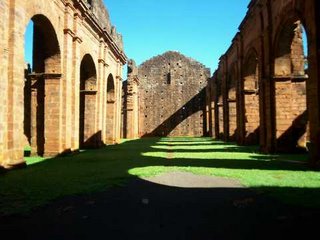 Esta é a sua visão quando você entra na Igreja de São Miguel do Arcanjo. Infelizmente nesta hora do dia as sombras estavam cobrindo boa parte da nave da Igreja. Detalhe que não se vê na foto é que nalgumas partes das paredes, repara-se o pretume causado por incêndios no passado. This is the view when you get into São Miguel Miguel do Arcanjo Church. Unfortunately in this time of the day there was heavy shadows inside. Some parts of the walls are darkened due to fire happened in the past.
Esta é a sua visão quando você entra na Igreja de São Miguel do Arcanjo. Infelizmente nesta hora do dia as sombras estavam cobrindo boa parte da nave da Igreja. Detalhe que não se vê na foto é que nalgumas partes das paredes, repara-se o pretume causado por incêndios no passado. This is the view when you get into São Miguel Miguel do Arcanjo Church. Unfortunately in this time of the day there was heavy shadows inside. Some parts of the walls are darkened due to fire happened in the past.
Monday, June 19, 2006
A Igreja / The Church
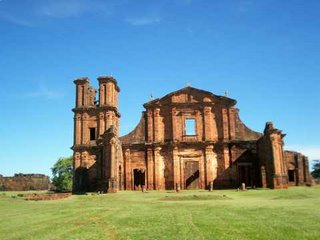 Igreja de São Miguel do Arcanjo, vista de frente. Do lugar de onde tirei a foto ficava a praça. Atrás de mim, estão os vestígios das casas que os guaranis moravam. A Igreja, como em toda a sociedade antiga, era o centro da vida das pessoas. Na Igreja as pessoas eram batizadas, casavam e o padre concedia a extrema-unção. Não havia registro civil, quem administrava a cidade e registrava os atos da vida civil dos moradores era a Igreja. A construção da Igreja, de estilo barroco, foi iniciada pelo arquiteto jesuíta Jean Baptista Primoli, em 1735, e levou dez anos para ser concluída. Incêndios que aconteceram no passado levaram a modificações de sua forma original, diminuindo de tamanho. É contado que ela nunca chegou a ser terminada, porque a torre do lado direito não foi construída, uma vez que as Missões foram abandonadas antes do término da segunda torre. São Miguel do Arcanjo Church front view. I took this shot were was the square of the village. Behind me, is possible to see some stones that in the past was the native´s house. The Church, like any other ancient society, was the center of the people´s life. The construction of the church, projected by jesuit architet Jean Baptista Primoli, began in 1735, and took 10 years to be finished. The church was never finished since the right tower is missing. The Missions was abandoned before.
Igreja de São Miguel do Arcanjo, vista de frente. Do lugar de onde tirei a foto ficava a praça. Atrás de mim, estão os vestígios das casas que os guaranis moravam. A Igreja, como em toda a sociedade antiga, era o centro da vida das pessoas. Na Igreja as pessoas eram batizadas, casavam e o padre concedia a extrema-unção. Não havia registro civil, quem administrava a cidade e registrava os atos da vida civil dos moradores era a Igreja. A construção da Igreja, de estilo barroco, foi iniciada pelo arquiteto jesuíta Jean Baptista Primoli, em 1735, e levou dez anos para ser concluída. Incêndios que aconteceram no passado levaram a modificações de sua forma original, diminuindo de tamanho. É contado que ela nunca chegou a ser terminada, porque a torre do lado direito não foi construída, uma vez que as Missões foram abandonadas antes do término da segunda torre. São Miguel do Arcanjo Church front view. I took this shot were was the square of the village. Behind me, is possible to see some stones that in the past was the native´s house. The Church, like any other ancient society, was the center of the people´s life. The construction of the church, projected by jesuit architet Jean Baptista Primoli, began in 1735, and took 10 years to be finished. The church was never finished since the right tower is missing. The Missions was abandoned before.
Sunday, June 18, 2006
A cruz e a Igreja / The cross and the church
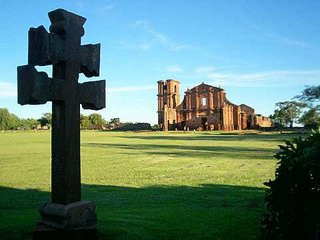 A clássica visão da Igreja de São Miguel do Arcanjo sob a sombra da cruz missioneira. No lado esquerdo da Igreja, há os remanescentes da casa dos padres, o colégio e as oficinas. Do lado direito, ficava o cemitério e o cotiguaçu, onde viviam as viúvas e os órfãos. O Museu das Missões, projetado pelo arquiteto Lúcio Costa está atrás desta foto, do lado esquerdo. Classic vision of the São Miguel do Arcanjo Church under the Company of Jesus cross. On the left side of the church, there is ruins of the priests house, the school and the workshops. On the right side of the Church, there is the ruins of the cemetery and "the cotiguaçu" , the place where take care of widows and orphans. Museum of the Missios, projected by architect Lúcio Costa, is behind me, on the left side.
A clássica visão da Igreja de São Miguel do Arcanjo sob a sombra da cruz missioneira. No lado esquerdo da Igreja, há os remanescentes da casa dos padres, o colégio e as oficinas. Do lado direito, ficava o cemitério e o cotiguaçu, onde viviam as viúvas e os órfãos. O Museu das Missões, projetado pelo arquiteto Lúcio Costa está atrás desta foto, do lado esquerdo. Classic vision of the São Miguel do Arcanjo Church under the Company of Jesus cross. On the left side of the church, there is ruins of the priests house, the school and the workshops. On the right side of the Church, there is the ruins of the cemetery and "the cotiguaçu" , the place where take care of widows and orphans. Museum of the Missios, projected by architect Lúcio Costa, is behind me, on the left side.
Friday, June 16, 2006
Igreja de São Miguel do Arcanjo / São Miguel do Arcanjo Church
 Antes de serem postadas as fotos, vale mostrar a Igreja de São Miguel do Arcanjo, na sua forma original. A Redução de São Miguel do Arcanjo (atual São Miguel das Missões) foi fundada em 1632, logo depois foi abandonada em virtude dos constantes ataques dos bandeirantes paulistas. Persistindo, houve retorno dos guaranis e jesuítas em 1687, vindo a iniciar a construção do novo povoado em sua localização definitiva. São Miguel das Missões se desenvolveu ao redor dos vestígios da Igreja de São Miguel do Arcanjo. I´d like to show firstly São Miguel do Arcanjo Church in its original architeture. São Miguel do Arcanjo Reduction (today São Miguel das Missões) was founded in 1632. After that was abandoned due to settlers constant attacks. However, indians and Jesuits Priests returned in 1687, they began to build the definitive of the new village. São Miguel das Missões developed around the ruins of the Church of São Miguedl do Arcanjo.
Antes de serem postadas as fotos, vale mostrar a Igreja de São Miguel do Arcanjo, na sua forma original. A Redução de São Miguel do Arcanjo (atual São Miguel das Missões) foi fundada em 1632, logo depois foi abandonada em virtude dos constantes ataques dos bandeirantes paulistas. Persistindo, houve retorno dos guaranis e jesuítas em 1687, vindo a iniciar a construção do novo povoado em sua localização definitiva. São Miguel das Missões se desenvolveu ao redor dos vestígios da Igreja de São Miguel do Arcanjo. I´d like to show firstly São Miguel do Arcanjo Church in its original architeture. São Miguel do Arcanjo Reduction (today São Miguel das Missões) was founded in 1632. After that was abandoned due to settlers constant attacks. However, indians and Jesuits Priests returned in 1687, they began to build the definitive of the new village. São Miguel das Missões developed around the ruins of the Church of São Miguedl do Arcanjo.
Wednesday, June 14, 2006
São Miguel das Missões
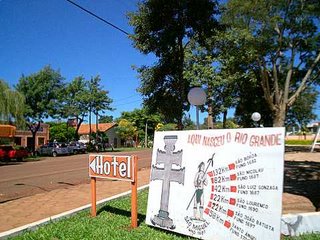 Entrada da zona urbana de São Miguel das Missões. Esta imagem diz muito sobre o lugar. Céu azul, terra vermelha e a inscrição "Aqui nasceu o Rio Grande", ao lado da cruz missioneira, juntamente com a figura do índio guarani, retrata o orgulho daquela gente pela sua terra. Para chegar ao principal sítio arqueológico do local deve-se seguir a rua duas quadras adiante e dobrar a direita. Begining of the urban zone of São Miguel das Missões. This picture says a lot about this place: blue sky, red land, and on the poster there´s the Company of Jesus Cross, an indian and it says "State of Rio Grande do Sul was Born Here". retracts the proud of the people who live there. To reach main archeological site you have to walk two blocks ahead and turn right.
Entrada da zona urbana de São Miguel das Missões. Esta imagem diz muito sobre o lugar. Céu azul, terra vermelha e a inscrição "Aqui nasceu o Rio Grande", ao lado da cruz missioneira, juntamente com a figura do índio guarani, retrata o orgulho daquela gente pela sua terra. Para chegar ao principal sítio arqueológico do local deve-se seguir a rua duas quadras adiante e dobrar a direita. Begining of the urban zone of São Miguel das Missões. This picture says a lot about this place: blue sky, red land, and on the poster there´s the Company of Jesus Cross, an indian and it says "State of Rio Grande do Sul was Born Here". retracts the proud of the people who live there. To reach main archeological site you have to walk two blocks ahead and turn right.Sunday, June 11, 2006
No portal das Missões / Missions gateway
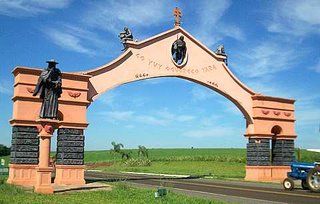 Enfim, São Miguel das Missões! Este é o pórtico da entrada da cidade. A área urbana está 16 km adiante. A figura que está a esquerda da foto é um padre jesuíta. Homenagem e reconhecimento da cidade à Ordem Religiosa que foi fundamental na sua história. São Miguel das Missões at least! This is the gateway of the city. Urban area is 16 km ahead. The statue on the left of the picture is a Jesuit Priest. A tribute to Religious Order that constructed the history of the city.
Enfim, São Miguel das Missões! Este é o pórtico da entrada da cidade. A área urbana está 16 km adiante. A figura que está a esquerda da foto é um padre jesuíta. Homenagem e reconhecimento da cidade à Ordem Religiosa que foi fundamental na sua história. São Miguel das Missões at least! This is the gateway of the city. Urban area is 16 km ahead. The statue on the left of the picture is a Jesuit Priest. A tribute to Religious Order that constructed the history of the city.Saturday, June 10, 2006
Santos missioneiros / Saints from the missions
Detalhes das estátuas dos santos padroeiros das missões que fazem parte da fachada da Catedral Angelopolitana, esculpidas por Valentin von Adamovich em 1920. Closeup of the statues of the Angelopolitan Cathedral wich celebrates the saints who inspirated the name of the Missions, they were build by Valentin von Ademovich in 1920.
Wednesday, June 07, 2006
Sob a cruz missioneira / Under the missionary cross
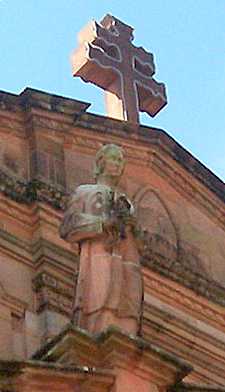 A Catedral Angelopolitana é muito rica em detalhes, que na hora das fotos nem percebi. Mas graças à tecnologia pude reviver alguns detalhes que hora eu perdi. Na fachada da catedral estão as estátuas de todos os sete santos que deram o nome às missões. À esquerda, está um deles, sob a cruz missioneira. The Cathedral is very rich in detais that I couldn´t notice when I took this shots. But thanks to technology I could revamp some details that I missed. In the Cathedral Angelopoltan façade there´s the statues of the saints who gave the name to Missions. On the left, there´s one of them, under the missionary cross.
A Catedral Angelopolitana é muito rica em detalhes, que na hora das fotos nem percebi. Mas graças à tecnologia pude reviver alguns detalhes que hora eu perdi. Na fachada da catedral estão as estátuas de todos os sete santos que deram o nome às missões. À esquerda, está um deles, sob a cruz missioneira. The Cathedral is very rich in detais that I couldn´t notice when I took this shots. But thanks to technology I could revamp some details that I missed. In the Cathedral Angelopoltan façade there´s the statues of the saints who gave the name to Missions. On the left, there´s one of them, under the missionary cross.
Tuesday, June 06, 2006
 Aproveitando a estada em Santo Ângelo, fui conhecer a Catedral Angelopolitana, que foi construída no mesmo local onde ficava a Igreja da Redução de Santo Ângelo de Custódio. A Catedral Angelopolitana foi construída em 1920 e a sua arquitetura foi inspirada no estilo barroco da Igreja da Redução de São Miguel de Arcanjo, que fica em São Miguel das Missões. In Santo Ângelo I visited Angelopolitana Cathedral, build in the same place where the Church of the 'Reduccion' of Santo Ângelo de Custódio. It was build in 1920 and his architeture was inspired in the Church of 'Reduccion de São Miguel de Arcanjo' in São Miguel das Missões
Aproveitando a estada em Santo Ângelo, fui conhecer a Catedral Angelopolitana, que foi construída no mesmo local onde ficava a Igreja da Redução de Santo Ângelo de Custódio. A Catedral Angelopolitana foi construída em 1920 e a sua arquitetura foi inspirada no estilo barroco da Igreja da Redução de São Miguel de Arcanjo, que fica em São Miguel das Missões. In Santo Ângelo I visited Angelopolitana Cathedral, build in the same place where the Church of the 'Reduccion' of Santo Ângelo de Custódio. It was build in 1920 and his architeture was inspired in the Church of 'Reduccion de São Miguel de Arcanjo' in São Miguel das Missões
Sunday, June 04, 2006
Caminhos da produção / Production Road
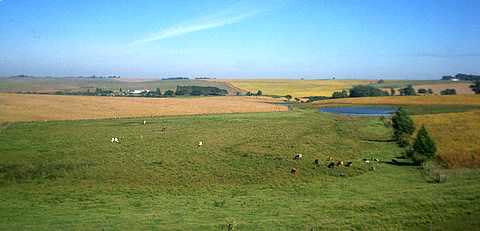
Algum lugar do Rio Grande do Sul, entre Cruz Alta e Santo Ângelo, não importa: o que importa na foto são as cores vivas da paisagem que mostram por si a força da agropecuária da região. Shot from somewhere in Rio Grande do Sul, between cities of Cruz Alta and Santo Ângelo, it doesn´t matter: live colors of the landscape shows by itself the strenght of the agrobusiness of this land.
Saturday, June 03, 2006
Região das Missões / Missions Region
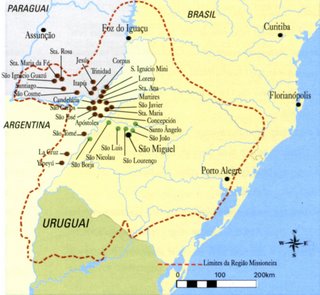 Região das Missões: No lado da fronteira brasileira, elas foram construídas em São Borja, São Nicolau, São Luís Gonzaga, São Lourenço, São Miguel, São João Batista e Santo Ângelo. O sítio mais importante no Brasil é o de São Miguel. A Catedral de São Miguel do Arcanjo, construída em São Miguel das Missões, é o único monumento no Rio Grande do Sul reconhecido pela UNESCO como patrimônio da humanidade. Missions Region: on the brazilian side, they were build in São Borja, São Nicolau, São Luís Gonzaga, São Lourenço, São Miguel, São João Batista e Santo Ângelo. The most import archeological site in Brazil is São Miguel das Missões, where it was build São Miguel do Arcanjo Cathedral, the only monument in the State of Rio Grande do Sul, recognized by UNESCO as a monument of the mankind.
Região das Missões: No lado da fronteira brasileira, elas foram construídas em São Borja, São Nicolau, São Luís Gonzaga, São Lourenço, São Miguel, São João Batista e Santo Ângelo. O sítio mais importante no Brasil é o de São Miguel. A Catedral de São Miguel do Arcanjo, construída em São Miguel das Missões, é o único monumento no Rio Grande do Sul reconhecido pela UNESCO como patrimônio da humanidade. Missions Region: on the brazilian side, they were build in São Borja, São Nicolau, São Luís Gonzaga, São Lourenço, São Miguel, São João Batista e Santo Ângelo. The most import archeological site in Brazil is São Miguel das Missões, where it was build São Miguel do Arcanjo Cathedral, the only monument in the State of Rio Grande do Sul, recognized by UNESCO as a monument of the mankind.
Friday, June 02, 2006
Esta terra é a minha Terra / This land is my Land

Esta Terra é a Minha Terra..
Infelizmente, nos acostumamos com a idéia de que o Rio Grande do Sul é um lugar de belas serras, da urbanizada Porto Alegre e das praias do litoral para onde vamos durante as férias.
Esquecemo-nos da incrível história das missões, que está ligada as raízes do Rio Grande do Sul. Na verdade foi quando tudo começou...
Um pouco de história
No século XVI, em oposição aos métodos de evangelização da Igreja Católica, surgiu a Ordem da
Companhia de Jesus, fundada pelo Santo Ignácio de Loyola. Seus membros eram chamados de Jesuítas. Na tradição cristã, as ordens religiosas são as associações os homens ou as mulheres que procuram conduzir a uma vida de oração e práticas caridosas e que são devotadas freqüentemente a algum formulário específico do serviço. Os membros ligam-se geralmente publicamente, ou às vezes confidencialmente, por votos da pobreza, do castidade e de obediência para conduzir a uma vida dedicada.
Assim era a Companhia de Jesus.
Os Jesuítas vieram às Américas em 1567, em Viceroyalty no Peru. Escolheram um método de evangelização chamado de 'Missão'.
No entanto, a crise administrativa interna do Peru durante o Século XVI, a exploração indiscriminada dos nativos pelos conquistadores, a fraqueza da ordem religiosa, a falta de controle administrativo e fiscal e insuficiente ação missionária, levou Viceroy Francisco de Toledo organizou as chamadas Reduções` dos indígenas.
Assim, a partir de 1609, a Província Jesuítica do Paraguai colonizou um imenso território onde, durante quase 160 anos, com os índios Guarani, desenvolveu-se um sistema social cooperativo, em um território hoje dividido entre Argentina, Brasil, Paraguai e Uruguai. Em 1743, havia 141 182 índios vivendo em trinta povoados, representando 54% da população das províncias do Prata. Para pesquisas, sugiro este link.
As Reduções
As reduções não eram aldeias, mas verdadeiras cidades que se instalavam nas selvas, com toda a infra-estrutura; além da igreja, que era o centro de tudo, havia hospital, asilo, escolas, casa e
comida para todos e em abundância, oficinas e até pequenas indústrias. Fabricavam-se todos os
instrumentos musicais, tão bem quanto na Europa, por exemplo. Imprimiam-se livros em plena selva, alguns até em alemão.
Possuíam observatório astronômico e até editavam uma carta astronômica e um boletim meteorológico.
Foi nessas reduções que se começou a industrializar o ferro, a produzir os primeiros tecidos, e a se riar gado no continente. Foi esse gado, espalhado pelos pampas de todo o Sul, que acabou definindo a vocação econômica do Rio Grande do Sul: a pecuária, de alguma forma ligada a todos os seus acontecimentos históricos.
Parte do texto obtido aqui.
O Fim
Em 1750, com o Tratado de Madrid, as reduções localizadas em território hoje brasileiro passam a pertencer à Portugal. Este fato desencadeou a Guerra Guaranítica, onde surge o lendário guerreiro guarani Sepé Tiaraju e seu brado heróico: “ ...esta terra tem dono!”
Embora os guaranis obtiveram êxito no início dos combates contra as tropas luso-espanholas por causa de sua bravura, mobilidade tática e conhecimento do terreno, no fim prevaleceu a tecnologia e o poder de fogo das tropas das coroas espanhola e portuguesa.
Somente circulando na região missioneira, visitando seus marcos, convivendo com sua gente, ouvindo suas histórias é possível sentir o que foi a grandiosidade do conjunto de fatos históricos que aconteceram nestas paisagens.
This Land is my Land..
As I wrote earlier, on 29th march I went to Missions Region. It was an unforgivable experience. Unfortunately we get used to idea the Rio Grande do Sul State is a place of beautiful mountains, an urbanized capital Porto Alegre and the beaches of the coast where we go during the holidays. We forget the amazing history of the Missions, that it´s linked to our origins. It´s the place where everything begins. History In the XVI Century, in oposition to Catholic Church evangelization methods, it was founded the Society of Jesus, by Ignácio de Loyola. Their members was called jesuits. In christian tradition this kind of societies, are a group of men or women who lives a life dedicated to pray and carity practices following an specific religious ritual. Jesuits come to America in 1567, they arrived in Viceroyalty, Peru. They chose an evangelization method called 'mission'. However, the administrative crises in Peru during XVI Century, the native indiscriminated exploitation by the conqueers,the weakness of the religions orders, the lack of administrative control to missionary actions, led Veceroy Veceroy Francisco de Toledo organize the called 'Reductions' of the natives. Thus, in 1609, Jesuits colonized an huge territory where during 160 years, it was developed a social system where spreads in the territory of Argentina, Brazil, Paraguay and Uruguay. In 1743 there was 141,182 natives living in 30 settlements, it corresponds to 54% of the provinces of the Plata River The Reductions Actually, reductions was not just villages, but was urban nuclei where jesuits and natives live in the jungle, with complete infra-estructure: the church, where the life develops since by birth until death, hospital, home for elders and widows, schools, houses and food to everyone and even small factories. Music instruments was build, books was pressed even in German language. Reductions also had observatory, created astronomic charts, forecasts and so for. In the Reductions the iron industrialization begans, the production of fabric as well. Aslo they founded ranches. Cattle is an important economic activity in the State of the Rio Grande do Sul today.
The End
In 1570, treaty of Madrid ruled the reductions localized in the brazilian territory become property of the Portugal Kingdon. Natives didn´t accept and began the war called Guaranitical (from the word Guarani, native) Wars. Native resistence was coordinated by the native 'Sepe Tiaraju' and his historical slogan: "This land has an owner!". Although navites was victorious in the early begining the war against luso and hispanic troops due to knowledge of the terrain, more entusiasm and tactical mobility, the troops of the kingdon prevail due to technological superiorty and fire power. Only if you visit the Mission Region visiting its landmarks, living with the people, hear their histories is possible to feel how grandious was the historic period of the early history of Rio Grande do Sul.
Subscribe to:
Posts (Atom)



